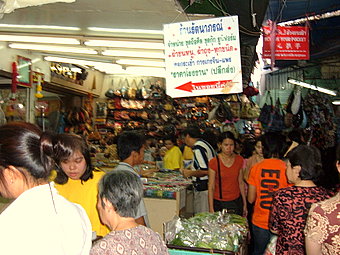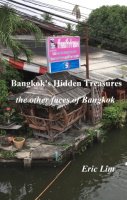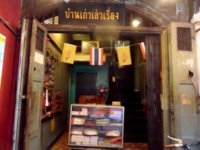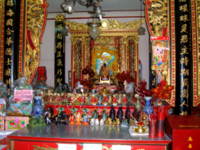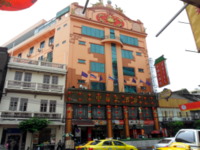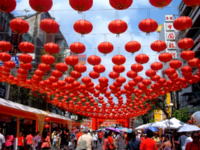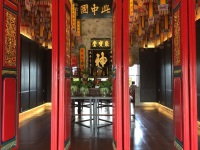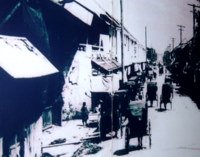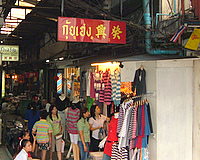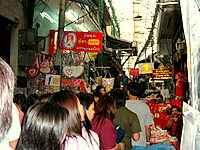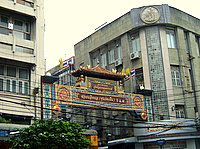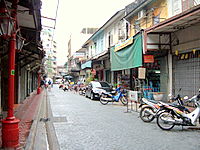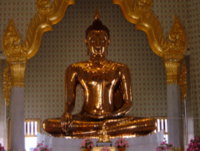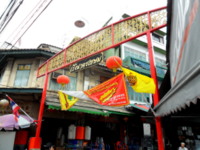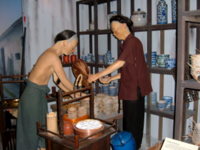- Home
- Chinatown Bangkok
Chinatown Bangkok
Yaowarat the Chinese legacy
By Eric Lim
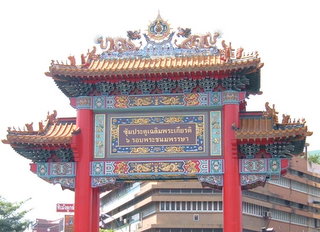
Odean Gate at the dragon's head
Chinatown Bangkok or Yaowarat was started when King Rama I decided in 1782 to establish the capital on the eastern bank of the Chao Phraya River. The Chinese immigrants who were originally settled in what is now the Grand Palace had to move out to a strip of land two km down the river.
Over the years the settlement grew. Today Chinatown Bangkok or Yaowarat covers a square bounded by Phadung Krung Kasem Canal to the east, the Ong Ang Canal to the west, Luang Road to the north and the Chao Phraya River to the south, an area of about 2 sq km.
For hotels in ChinatownThe casual visitor to Chinatown would probably only have the time and energy to cover the main street Yaowarat Road where most of the activities are concentrated.
The other road of interest is Rachawong Road which is off Yaowarat Road.
If you are coming to Chinatown by road the most convenient way to start your tour of this Bangkok legacy is to take the underground to the Hua Lam Phong underground station located on the eastern bank of the Phadung Krung Kasem Canal.
Nearby is the Hua Lam Phong railway station from which trains travel to every part of Thailand.
Across the road from the train station is Traimit Road where the famous Wat Traimit or Temple of the Golden Buddha stands. This wat houses a 3 m high Buddha made of more than 5 tonnes of gold!
The Golden Buddha is now in a new building with the Golden Buddha Museum on the second level and the Yaowarat Heritage Centre on the first level.
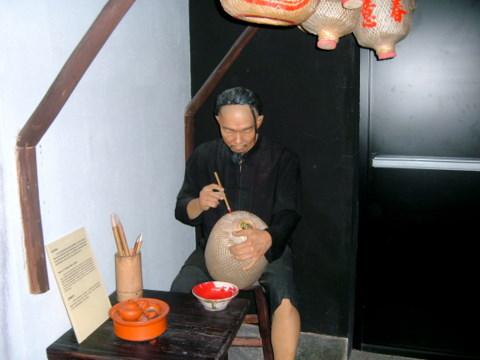
Yaowarat Heritage Centre
The Samphanthawong Museum a community museum dedicated to the early Chinese immigrants in Bangkok which was previously in the grounds of Wat Traimit. It has moved to the Wat Prathum Khongkha School.
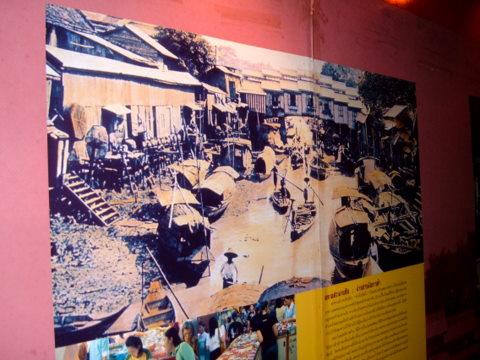
Samphanthawong Museum
Outside the main entrance of Wat Traimit is a traffic island on which stands a huge Chinese arched gate, the Odean Gate, built in 1999 to mark the 72nd birthday of King Bhumipol, the present king. This gate marks the start of Yaowarat Road and the walking tour of the rest of Chinatown.
Yaowarat Road, the main street in Chinatown Bangkok, was built in the reign of King Rama V. The crowded street winds through the bustling heart of Chinatown like a mythical dragon rearing its head at the Odean Gate, an auspicious sign to the residents.
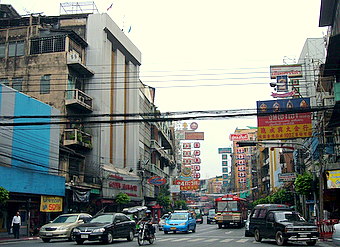
The mythical dragon Yaowarat Road – distinctly Chinatown
Traveling to Chinatown became more convenient, business picked up rapidly and Yaowarat soon became the city's first commercial district. It still does brisk trade today.
Shop signs in both Thai and Chinese give the visitor a clear indication that he's in Chinatown.
The street is lined with ubiquitous goldsmith shops, sharksfin and birds nest restaurants, shops and vendors selling Chinese herbal medicine, dried mushrooms, salted fish, roast, Chinese calendars, almanacs and of course, lottery tickets. The avid bargain hunter would have a ball a time browsing through the shops and stalls.
Every year during the Chinese New Year, Yaowarat Road is closed to traffic for street festivities, lion dances and food fairs. A member of the royal family graces the occasion to the joy and pride of the Yaowarat community.
For the royal visit to Chinatown Bangkok during Chinese New Year in Bangkok 2006.
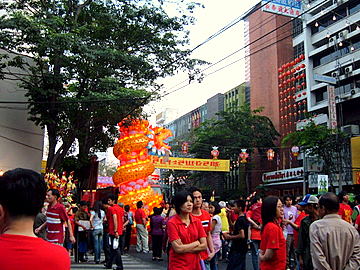
Chinese New Year 2006 – the Year of the Dog
Hotels in Chinatown
There're a number of reasonably priced hotels in Chinatown Bangkok. The Bangkok Centre Hotel and SK Boutique Mahanakhon Hotel are near the Hua Lam Pong subway terminal station just a five minute walk to Yaowarat.
The other hotels in Chinatown are located in bustling Yaowarat Road like Check Inn Chinatown Chinatown Hotel Bangkok and Shanghai Mansion Bangkok.
The most prominent hotel however is the Grand China Hotel at the Ratchawong junction, right in the heart of Chinatown, overlooking the old city and the Chao Phraya River.
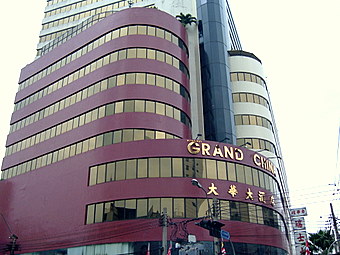
Grand China Hotel, Bangkok
About a kilometre down Yaowarat Road turn left into Ratchawong Road another street full of vendors selling everything from stickers, deep-fried tit-bits to roasted chestnuts. Ratchawong Road has two significant historical landmarks in Chinatown Bangkok.
Fifty metres after turning into Rachawong Road you'll encounter a tall Chinese arch to a narrow soi on the left. During the Chinese New Year in 2004, Her Majesty the Queen and the Crown Princess visited Chinatown. On that occasion, this soi, Soi Phalittaphon, was renamed Soi Sun Yat Sen after the father of the Chinese revolution.
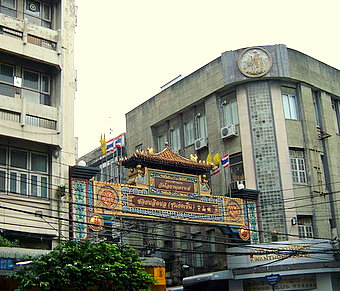
Soi Sun Yat Sen
Dr Sun visited Chinatown Bangkok in 1908 during his tour of South East Asia to raise money from the overseas Chinese for the revolution.
Walking through this narrow soi, the visitor would have to cope with the crowds of shoppers and the frequent passage of vehicles. The shops and stalls along this packed soi sell a variety of goods and even Christmas trees.
Further along Rachawong Road is an even narrower soi to the right of the road. The soi is so congested that it's barely passable to human traffic. Packed with stalls on either side, it would take a very determined shopper to weave his way through.
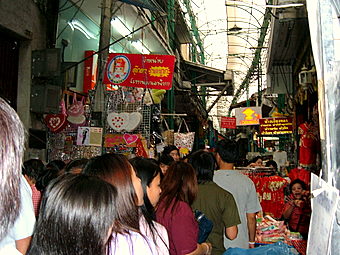
Soi Sampheng where Chinatown started
It's difficult to imagine that this is the famous Soi Sampheng or Soi Wanit where the Chinese settlers first moved in and started Chinatown in Bangkok.
At the end of Rachawong Road is the Rachawong Pier on the Chao Phraya River. If you are coming by boat, this is the pier to alight and start your of Chinatown in reverse. If you have arrived by road, you may wish to leave by boat for a change.
However, you may wish to continue with your tour of Chinatown Bangkok from the Ratchawong junction till the end of Yaowarat Road. Here you'll find Saphan Han an old market community by the Rob Krung canal, the dragon's tail at the end of Yaowarat Road.
Besides the main street Yaowarat Road, there's another side to Chinatown Bangkok. This is Walking Street Chinatown which is parallel to the main street. Walking Street links areas of historical interest and local community life over a 2 km stretch and it shows a different aspect of Chinatown, one that visitors to the main street rarely see.
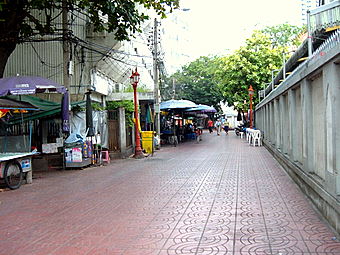
Walking Street outside the Holy Rosary Church
Another historical walking tour of Chinatown covering a different network of alleys is featured in Chinatown sights which covers quaint Chinatown landmarks and old shopping alleys.
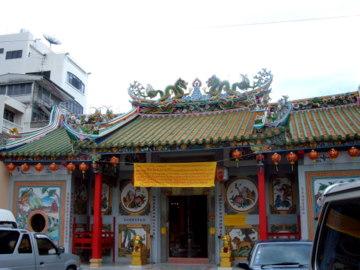
Shrine in old Chinatown
At the northern edge of Chinatown Bangkok opposite Saphan Han, there is a century-old community called Werng Nakhon Kasem may be in danger of extinction. In mid-2012, the area was sold and the new owners may have plans for redevelopment.
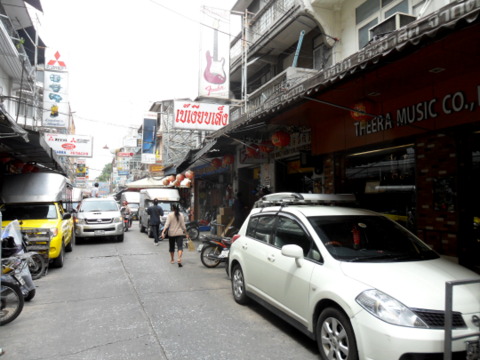
Werng Nakhon Kasem
The Charoen Chai community is another old community under the pressure of modern development. The history, culture and way of life of this old community is preserved in an old house converted to a community museum. Find out more about the history of this community, what’s it’s like today and what’s its future at Ban Kao Lao Rueng.
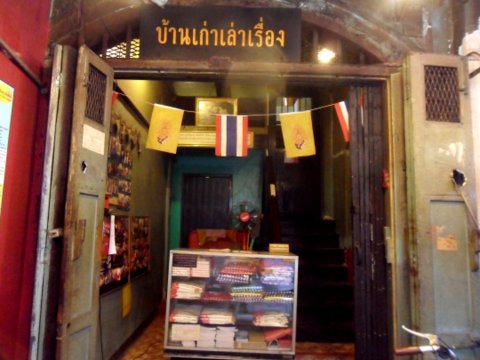
Entrance to the community museum
Just across the river from Talat Noi and Yaowaraj is a cluster of old warehouses and a pier built more than 160 years ago. Strictly speaking it's not part of Bangkok's Chinatown but this place holds a significant segment of Bangkok's history and the history of the early Chinese immigrants to old Siam.
Find out more about the cultural legacy of Lhong 1919.
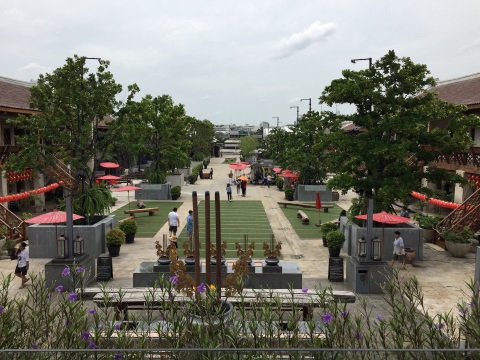
Lhong 1919 – preserving the Chinese heritage
A tour of Chinatown Bangkok provides a fascinating insight into a very different way of life. With 10 temples, 20 shrines, old shops, markets and homes, Chinatown is a wealth of cultural treasures which thankfully have been preserved for more than two centuries.
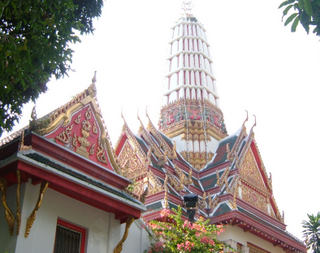
Wat Chakkrawat one of the many temples in Chinatown Bangkok
Map of Chinatown Bangkok
View Map of Chinatown Bangkok in a larger map
How to get there
By MRT Blue Line
If you wish to start your tour at Wat Traimit and the Odean Gate, the dragon's head, take the MRT Blue Line to BL28 Hua Lam Phong Station. Or you can alight at BL29 Wat Mangkon Station which is right in Chinatown.
By boat
If you are coming by the Chao Phraya river boat the nearest pier is the N5 Ratchawong Pier at the end of Ratchawong Road.
This route takes you to the heart of old Chinatown, Soi Sampheng (Soi Wanit 1) the birthplace of the Chinese community. Saphan Han, at the dragon's tail is in this last section.
The busy streets are a melting pot of communities engaging in commerce and they're as busy as ever today. The legacy of the early Chinese immigrants and their enterprise lives on.
Bangkok’s Hidden Treasures – the other faces of BangkokThis is my third e-book which is a journal on my travels in Bangkok from late 2011 to early 2018. It’s a journey to the less traveled and lesser-known places in Bangkok, places that are treasure troves of history, art and culture of the diverse communities that make up Bangkok and Thailand.
This journey will take us from the rice fields of Nong Chok near the eastern city limits of Bangkok across the city to the canals in Thawi Wattana in the west.
Let's uncover these gems in Bangkok's hidden treasures together.
Search Tour Bangkok Legacies with DuckDuckGo
